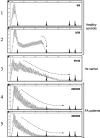Detection of large pathogenic expansions in FRDA1, SCA10, and SCA12 genes using a simple fluorescent repeat-primed PCR assay
- PMID: 15096564
- PMCID: PMC1867469
- DOI: 10.1016/S1525-1578(10)60496-5
Detection of large pathogenic expansions in FRDA1, SCA10, and SCA12 genes using a simple fluorescent repeat-primed PCR assay
Abstract
At least 18 human genetic diseases are caused by expansion of short tandem repeats. Here we describe a successful application of a fluorescent PCR method for the detection of expanded repeats in FRDA1, SCA10, and SCA12 genes. Although this test cannot give a precise estimate of the size of the expansion, it is robust, reliable, and inexpensive, and can be used to screen large series of patients. It proved useful for confirming the presence of large expansions in the Friedreich ataxia gene following an ambiguous result of long-range PCR, as well as rapid pre-screening for large repeat expansions associated with Friedreich ataxia and SCA10 and the shorter repeat expansions associated with SCA12.
Figures



References
-
- Ranum LPW, Day JW. Dominantly inherited, non-coding microsatellite expansion disorders. Curr Opinion Genet Dev. 2002;12:266–271. - PubMed
-
- Matsuura T, Yamagata T, Burgess DL, Rasmussen A, Grewal RP, Watase K, Khajavi M, McCall AE, Davis CF, Zu L, Achari M, Pulst SM, Alonso E, Noebels JL, Nelson DL, Zoghbi HY, Ashizawa T. Large expansion of the ATTCT pentanucleotide repeat in spinocerebellar ataxia type 10. Nat Genet. 2000;26:191–194. - PubMed
-
- Campuzano V, Montermini L, Moltò MD, Pianese L, Cossée M, Cavalcanti F, Monros E, Rodius F, Duclos F, Monticelli A, Zara F, Cañizares J, Koutnikova H, Bidichandani SI, Gellera C, Brice A, Trouillas P, De Michele G, Filla A, De Frutos R, Palau F, Patel FI, Di Donato S, Mandel J-L, Cocozza S, Koenig M, Pandolfo M. Friedreich’s ataxia: autosomal recessive disease caused by an intronic GAA triplet repeat expansion. Science. 1996;271:1423–1427. - PubMed
-
- Durr A, Cossèe M, Agid Y, Campuzano V, Mignard C, Penet C, Mandel J-L, Brice A, Koenig M. Clinical and genetic abnormalities in patients with Friedreich’s ataxia. N Engl J Med. 1996;335:1169–1175. - PubMed
-
- Montermini L, Andermann E, Labuda M, Richter A, Pandolfo M, Cavalcanti F, Pianese L, Iodice L, Farina G, Monticelli A, TuranoM, Filla A, De Michele G, Cocozza S. The Friedreich ataxia GAA triplet repeat: premutation and normal alleles. Hum Mol Genet. 1996;6:1261–1266. - PubMed
Publication types
MeSH terms
Substances
Grants and funding
LinkOut - more resources
Full Text Sources
Other Literature Sources
Medical

